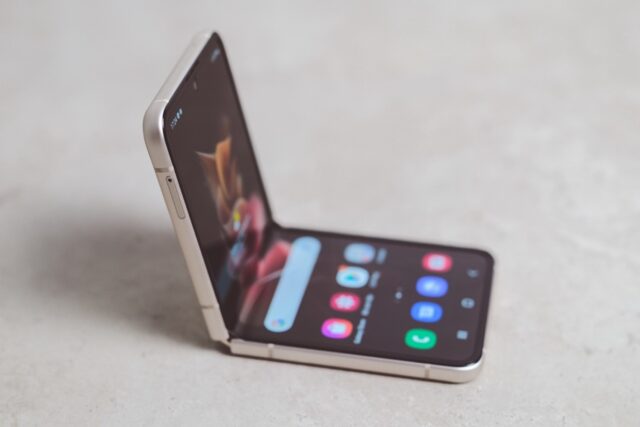Foldable Phones: Top or Flop?

If you’ve followed the evolution of mobile phones since their first introduction, you’ll surely remember the iconic foldable models that became extremely popular around the mid-90s and early 2000s, like the unforgettable first Motorola Rzr. Following a long period, these devices lost their ground to unibody phones, especially when smartphones became the only phone type available on the market, and now they’re back. And they look like something straight out of a sci-fi movie!
The new, revamped version of foldable phones consists of futuristic, sleek devices that effortlessly bend and twist, with great potential for transforming our lives. With such fantastic features, it’s no wonder they’re making waves among tech enthusiasts worldwide! But the question is: are these super advanced phones real game-changers, or are they just one of the many fads? In this blog, we’ll dig deeper into the fascinating world of foldable phones, breaking down their evolution and main benefits to find out whether they’re really a top-tech marvel or a total flop!
Folding through time: the evolution of foldable phones
Bypassing the 90s version, let’s focus on the present. The modern foldable phones that we know today have definitely come a long way from the days when we could only dream of them as if they were devices straight out of Blade Runner or other futuristic scenarios.
The innovative concept that led to the creation of today’s models first made waves with early prototypes and patents in the early 2010s. Fast forward to the late 2010s, when pioneering companies like Samsung and Huawei brought their first foldable models to the limelight. These were often met with criticism for not being as durable as other phone types, with reasonable concerns about creases and other screen issues. However, supported by the latest developments and progress, these manufacturers have made incredible strides since then, perfecting the hinge mechanisms and improving screen durability, which are seen as the core of these devices.
Now, the foldable phones on the market are far more reliable and sophisticated! They feature solid hinge systems, improved display technology, and better overall build quality, as well as new, trendy designs, such as the handy clamshell style and the book-style fold. It’s incredible how such advanced tech has evolved from a niche curiosity into a mainstream product, showing that foldable phones might be more than just a passing trend!

The benefits of foldable phones: big perks in a small package
If you’re a passionate tech buff, we know what’s on your mind right now. You’re probably thinking, “These devices look exceptional! I want to sell my phone and buy one.” But before we get there, you’re also probably wondering, “What’s the big deal with foldable phones?”. And we’re here to answer this question so you know what’s in it for you!
For starters, they offer the best of both worlds: the portability of a phone and the big screen of a tablet. And this alone should be a great reason for a phone trade-in! Now, this fantastic versatility can be a game-changer, particularly for avid media consumers. Imagine you’re you’re on the train, watching a video on a tablet-sized screen; then, when it’s time to get off, you can simply fold it up to slip it into your pocket. Basically, it’s like having your cake and eating it too—except it’s a phone, not a cake, and you can’t eat it!
 Another handy benefit is the multitasking capability. Many foldable phones come with advanced software features that allow for split-screen multitasking, making it easier to juggle between apps and boost productivity—much more so when you’re working on your computer with two screens! So, whether you’re video chatting while browsing the web or drafting emails and checking your calendar at the same time, modern foldable phones offer an incredibly efficient experience to make everyday tasks feel more fluid and enjoyable!
Another handy benefit is the multitasking capability. Many foldable phones come with advanced software features that allow for split-screen multitasking, making it easier to juggle between apps and boost productivity—much more so when you’re working on your computer with two screens! So, whether you’re video chatting while browsing the web or drafting emails and checking your calendar at the same time, modern foldable phones offer an incredibly efficient experience to make everyday tasks feel more fluid and enjoyable!
Fold or hold? Common criticisms and drawbacks
But, of course, it’s not all sunshine and rainbows, and yes, as much as they’re fascinating, foldable phones aren’t without flaws, which we could boil down to two main ones: durability and price. Let’s look into these.
Let’s talk durability. We’ve already mentioned that when these phones were first released, the main concerns revolved around their screens. Will they succumb to unavoidable wear and tear, or will they endure heavy daily use for longer periods? Despite many impressive technological advancements over the last few years, foldable phones are still considered more fragile than their unibody counterparts, with users reporting issues with screen creasing, hinge wear and tear, and even occasional software glitches. Unfortunately, these concerns can be a dealbreaker for those who prioritise longevity and reliability over shiny new features and design.
Price is another sticking point. These devices, such as the Samsung Galaxy Z Fold 6, for instance, generally come with a hefty price tag, often between £1,000-£2,000! This high cost can be a major downside for many consumers, especially when compared to traditional smartphones that offer similar functionalities at a much lower price. For those on a budget or who don’t see the added value, this factor might overshadow the benefits we outlined, triggering a burning question: does innovation justify the expense?
If price is not a big minus for you and you’re still thinking of selling your current iPhone or Samsung to get a modern foldable phone, use our Sell My iPhone or Sell My Samsung Galaxy S services and get cash right away; it’ll help you put your hands on one of these new tech wonders!
Are we there yet? What consumers think
Consumers and the general market have had mixed feelings about foldable phones, highlighting both excitement and scepticism. While tech enthusiasts have embraced these devices with passion and are thrilled by their features and futuristic appeal, mainstream acceptance is not there yet and is still evolving. In fact, many remain hesitant, expressing concerns about the durability issues and the high price we’ve mentioned above.
 Sales figures suggest a growing interest but not a universal endorsement. Tech giants like Samsung are keen on refining their products based on user feedback and remain hopeful that as technology advances and prices become more competitive, foldable phones will see broader acceptance. So, it’s safe to say that the trajectory suggests a promising future, but existing hurdles must be overcome and fixed!
Sales figures suggest a growing interest but not a universal endorsement. Tech giants like Samsung are keen on refining their products based on user feedback and remain hopeful that as technology advances and prices become more competitive, foldable phones will see broader acceptance. So, it’s safe to say that the trajectory suggests a promising future, but existing hurdles must be overcome and fixed!
What’s next? Future innovations in foldable phones
Looking ahead, the future of foldable phones is surely packed with exciting possibilities. With manufacturers already working on improving durability and a significant push towards enhancing the user experience to make multitasking even smoother and more intuitive, we’re positive these models are here to stay. On top of that, future designs could also bring even more versatility, like rollable screens and ultra-thin foldable models, which opens up new possibilities for how we interact with our devices. So, all in all, we can say the foldable phone market is still in its infancy, but the coming years promise to be full of surprises and innovations!
It remains to be seen whether they’re a success or a flop, but one thing’s for sure: they’ve certainly got people talking and dreaming about what’s next in tech!
If you’re thinking about making the leap into the world of foldable phones but are worried about the cost, at Mazuma, we can help make that transition happen! Trade in your old device with us! It’s super simple: Visit our website, get an instant quote, and send in your phone for free. You’ll get cash almost immediately, which can be put towards your shiny new foldable gadget. Do you have any questions? Just contact us, and we’ll be happy to help.
Don’t wait any longer; fold your way into the future today!

